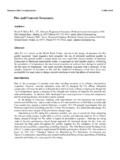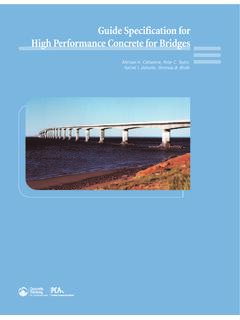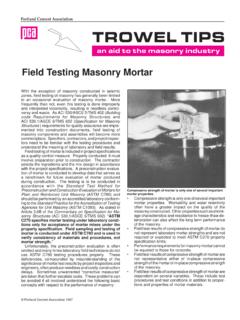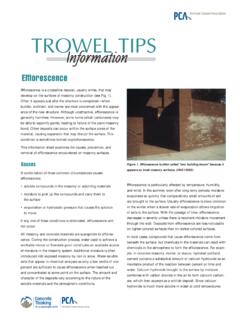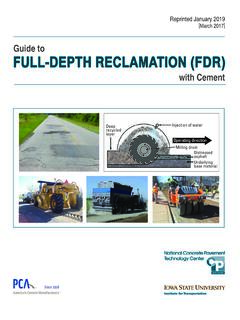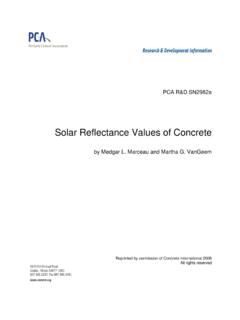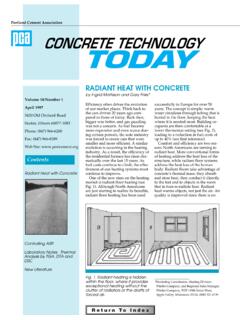Transcription of CONCRETE SEPTEMBER - cement.org
1 SPONSORED BYSEPTEMBER 2008A Special Section CONCRETE THE CHOICE FOR SUSTAINABLE DESIGNTMA LOOK INSIDE CONCRETE : energy and the Environment .. s2 Growing Benefi ts .. s4 Earning Points .. s8 Recycled Resources .. s12 Pervious Solution .. s14 Cover Photo: E2 City Homes uses ICFs, photo by Dana Wheelock, courtesy of LHB. ON energy EFFICIENCYIt might be materials that build the world, but today the design and construction industry is turning its gaze upon energy efficiency, the measure by which all new structures are now appraised as part of the evolving sustainabil-ity movement. If the greenest materials around don t result in a low- energy structure, why build with them? That s where CONCRETE comes in: There is no other more energy - efficient building material known to man, explains Brian McCarthy, presi-dent of the Portland Cement Association (PCA).
2 As a baseline, Buildings with CONCRETE external walls use up to 40 percent less energy than wood frame buildings, he to market research recently con-ducted by PCA, 77 percent of surveyed archi-tects, designers, engineers and other design professionals say they chose CONCRETE as their sustainable material for recent projects. In fact, energy efficiency was perceived as the most important attribute when selecting a building material, followed by durability and aesthetics. This focus on energy use is part of a big-ger effort by the building industry to step back and view sustainability as a big picture issue. In a very practical sense, sustainable develop-ment means looking at the total life cycle, says McCarthy.
3 This necessitates conducting more life-cycle assessments (LCAs) for materials and processes. We have to expand our definition it goes beyond cement, into CONCRETE , he industry is making strides in reducing its energy use and emissions. We still have to make changes in the manufacturing process, and the industry has committed to voluntary targets, says McCarthy, but true sustainable development does not begin and end with one component. NEW TECHNOLOGIES AND POLICIESIt s not just the design community s focus on energy efficiency that s driving change in the construction industry; new legislation from the federal level down to the smallest munici-palities is demanding more sustainability when it comes to repairing and building new infrastructure.
4 In Chicago, for example, an ordi-nance enacted in January 2008 creates more stringent requirements for stormwater manage-ment, spurring the use of pervious CONCRETE pavement throughout the city in alleys, park-ways, roadways and parking mixed CONCRETE companies are inno-vating, too, creating new products to solve fresh challenges posed by the sustainable movement. In Colorado, Recycled Materials Company cre-ated Biota from recycled CONCRETE runways at the former Stapleton Airport in Denver; the uniformly graded CONCRETE rubble is used as a protective layer to keep rodents from burrowing into entombed environmentally sensitive mate-rial on neighboring where CONCRETE itself can t be improved upon, firms like Dukane Precast in Naperville, Ill.
5 , are finding other ways to go greener, like using bio-based foam that partially substi-tutes castor or soybean oil for petroleum prod-ucts in its precast double wall S FORECASTG iven the snowballing sustainability movement, the cement industry is currently engaged in a $6 billion capacity expansion to accommo-date the growing need for CONCRETE . Ed Sullivan, chief economist for PCA, says that in the short term, some of this expansion will be postponed because of the current he stresses that the cement industry is ready. The next couple years will be challenging, and then strong growth rates in cement con-sumption are anticipated beyond 2010, Sullivan says in his most recent forecast. All that expansion is being built for a 2030 we re still looking at a 180 million ton market, says Sullivan.
6 Demand will be driven by a large expected population increase: Sixty-three million more people will be living in the United States in 2030 and they will need homes, schools, hospitals and roads. This construction will boost demand for cement to record levels. In the residential sector alone, expected growth (to more than triple today s numbers) in the use of insulating CONCRETE forms (ICFs) to build energy - efficient homes will have a major impact: If these green conditions mate-rialize residential CONCRETE construction will add roughly eight million metric tons to the cement intensities in 2030, Sullivan says. + energy AND ENVIRONMENT CONCRETE AT ITS CORE. BY JENNI PROKOPYSMALL TOWN TAKES CONCRETE TO THE EXTREMEIN GREENSBURG, KAN.
7 , CONCRETE IS LITERALLY THE BUILDING BLOCK ON WHICH THE TOWN STANDS. OR WILL STAND, THAT IS ON MAY 4, 2007, A MASSIVE TORNADO RIPPED THROUGH THE SMALL TOWN, DEVASTATING NEARLY EVERYTHING AND LEAVING A LONE CONCRETE SILO STANDING IN ITS WAKE. IT TOOK ONLY A FEW DAYS FOR FORM SYSTEMS, A NEARBY INSULATING CONCRETE FORM (ICF) MANUFAC-TURER, TO MOVE IN AND HELP KICK OFF THE REBUILDING OF GREENSBURG, STARTING WITH THE HOME OF THEN-MAYOR LONNIE MCCULLOM, USING ITS LOGIX BRAND OF ICF. LITTLE MORE THAN A YEAR LATER, THE TOWN IS FULLY COMMITTED TO BUILDING GREEN ALL THE WAY, WITH THE HELP OF COMPANIES AROUND THE NATION AND UNDER THE WATCHFUL EYE OF THE PRESS. (LEONARDO DICAPRIO HAS EXECUTIVE-PRODUCED A TV SERIES, GREENSBURG, DOCUMENT-ING THE TOWN S PROGRESS FOR DISCOVERY NETWORKS NEW STATION PLANET GREEN.)
8 ALMOST 25 STRUCTURES IN GREENSBURG ARE CURRENTLY BEING REBUILT WITH LOGIX ICFS, AND THE NEXT TWO YEARS SHOULD SEE MANY MORE, SAYS SCOTT RUDD, OPERATIONS MANAGER FOR FORM SYSTEMS. DANIEL WALLACH, DIRECTOR OF GREENSBURG GREEN TOWN A NONPROFIT HELPING MANAGE THE TOWN S RECONSTRUCTION SAYS FORMIDABLE CONCRETE STRUCTURES ARE JUST WHAT THE TOWNSPEOPLE NEED RIGHT NOW. THERE IS A LOT OF COMMON SENSE TO IT, HE SAYS. WHEN YOU VE LOST YOUR HOME TO A TORNADO, CONCRETE SOUNDS PRETTY GOOD. AND AS A BONUS, SAYS RUDD, THOSE NEW ICF HOMEOWNERS WILL CUT THEIR HVAC SYSTEMS INITIAL COSTS BY A THIRD AND EASILY ENJOY A 50 PERCENT SAVINGS ON energy articles in the CONCRETE section are written by Jenni Prokopy and sponsored by the Portland Cement Associ-ation. Prokopy is the founder of Orange Grove Media, LLC, an independent communi-cations firm providing writing and editing services, with almost 20 years in the com-munications business.
9 She received her Bach-elor of Science in Journalism degree from the Medill School of Journalism at Northwest-ern University, and has received numerous awards for her work as both a writer and as an activist with organizations like the Con-struction Writers Association. Contact her at courtesy of Logix USA HEADQUARTERS PUTS PHILOSOPHY INTO ACTIONIN WEST HOUSTON, CEMEX USA THE NATION S LARGEST CEMENT AND READY MIXED CONCRETE COMPANY IS SEEKING LEED CERTIFICATION OF ITS NEW HEADQUARTERS. IN EARLY 2009, THE MULTINATIONAL BUSINESS WILL MOVE INTO CEMEX CENTER, A 325,000-SQUARE-FOOT OFFICE BUILDING OF WHICH THE COMPANY WILL LEASE APPROXIMATELY HALF THE BY METRONATIONAL AND DESIGNED BY MORRIS ARCHITECTS, THE BUILDING S PRIMARY FOCUS IS ON energy EFFICIENCY; MUCH OF THE CONCRETE WILL REFLECT SUNLIGHT DURING THE DAY AND RADIATE LESS STORED HEAT AT NIGHT, REDUCING THE URBAN HEAT ISLAND EFFECT AND CUTTING COSTS ON AIR BUILDING EMPLOYS CONCRETE MIXES WITH CLASS C FLY ASH (AN INDUSTRIAL BYPRODUCT) AT A 25 PERCENT REPLACEMENT RATE, HELPING MAKE THE CONCRETE STRONGER, DENSER, MORE DURABLE AND MORE WORKABLE.
10 MOST OF THE MATERIALS USED IN THE CREATION OF APPROXIMATELY 32,000 CUBIC YARDS OF CONCRETE (FOR THE BUILDING AND ACCOMPANYING PARKING GARAGE) ARE MANUFACTURED WITHIN A 500-MILE RADIUS OF THE SITE. LOCATING OUR HEADQUARTERS IN AN OFFICE BUILT UPON SUSTAINABLE ECOLOGICAL AND ENVIRONMENTAL PRINCIPLES STRENGTHENS OUR COMPANY AND PRESERVES THE QUALITY OF LIFE FOR PRESENT AND FUTURE GENERA-TIONS, SAYS GILBERTO PEREZ, PRESIDENT OF CEMEX courtesy of CEMEX USA. Avoid disposal of material that would oth-erwise end up in a landfill. That s a primary goal in using alternative fuels and materials for the manufacture of cement, and according to Andy O Hare, vice president of regulatory affairs for the Portland Cement Association (PCA), the cement industry is making huge strides toward maximizing this practice.
